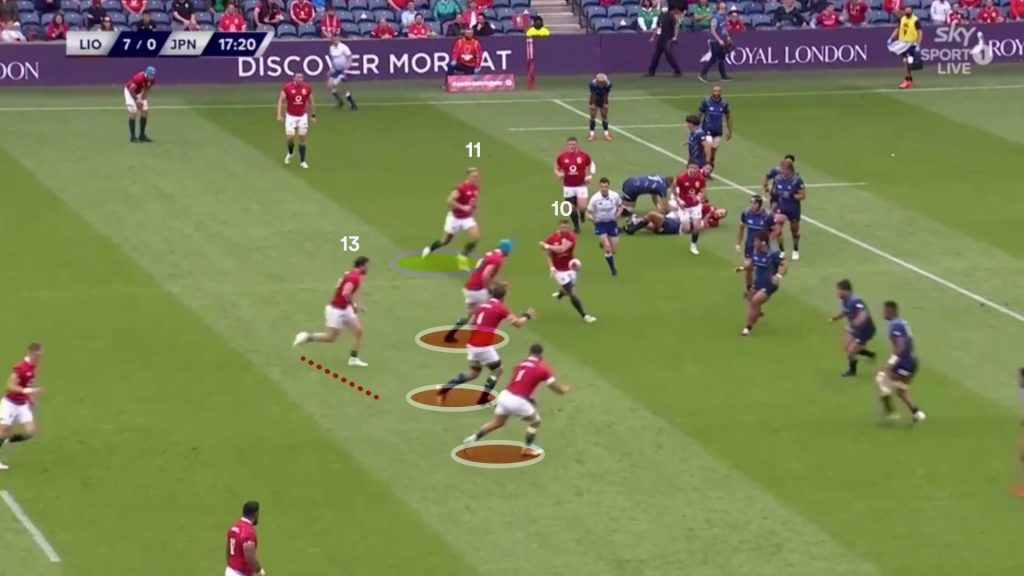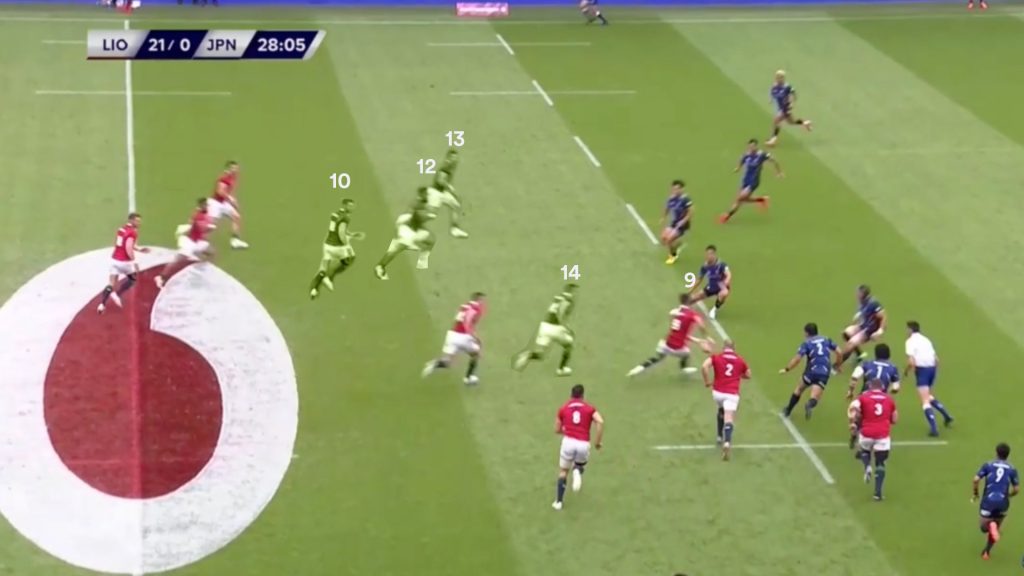The highly anticipated first test for the British & Irish Lions against Japan was a solid building block for Warren Gatland’s men, but highlighted how much work there is to do before they run out against the Springboks.
Make no mistake, there is little for the Springboks to glean from this match in terms of what tactical approach will be taken in South Africa.
The Lions’ first attacking wave inside Japan’s 22 was a heavy set of rolling phases, with forward runner after forward runner trucking around the corner, before Conor Murray was caught isolated after sniping from the base.
It was a slow, grinding style of bullying-rugby tailor made for Japan.
Perhaps some individual tendencies and rust may have been noted, but this game plan was all about beating the Brave Blossoms. The Lions found Japan couldn’t match or withstand their power, and proceeded to bulldoze their way to victory.
It is clear the Lions have a lot of work to do to build more fluent combinations to find the level of chemistry required against tougher opposition, particularly in the backs. If they want to play with more enterprise and have the option to stretch the South Africans with speed and width, there needs to be more.
Full of fresh and untried combinations, the Lions backline did not gel all that well with ball-in-hand. There were promising performances as individuals, but as a unit they weren’t able to find that desired level of execution when called upon.
The first attacking launch that displayed a desire to use the backs ended with confusion, as halfback Murray slowed play down by switching back to a short side full of forwards.
Throughout the sequence, we saw a glimpse into the plan with Duhan van der Merwe (11), who trailed Dan Biggar (10) on every phase, looking to get into the action off his fly-half.
On the first phase from the short line out, Biggar hits his third forward runner for a midfield crash to setup a ruck to pivot from.



On the very next phase, we see Biggar’s arms flail in the air out of frustration as his scrum-half Murray takes play back to the short side for a carry with only three forwards stationed there, just as all the backs prepared for an open side strike.
It would be another two phases before the Lions are set to release the backs, but the momentum is lost and Japan have the defence well-resourced on that side. Biggar instead decides to hit Tadhg Beirne on a short crash ball.


The backs had to wait to get their hands on some quality ball, while van der Merwe would have to work harder for his opportunities.
His work rate paid dividends for the Lions a short while later, operating in the same fashion unhinged from the left flank. With a license to roam and find ways to inject into phase play, his willingness to look for work earns the left winger a try on the opposite flank.
As the Lions build some phases in their pattern, van der Merwe chases the play across the field all the way to the far side.


We see the South-African born wing loom inside Biggar as the play keeps going right, even as the Welsh flyhalf attempts a long cutout pass over the top to Josh Adams on the right wing.


Only by tracking play to the opposite touch line does this opportunity come. Van der Merwe (11) sneaks down the vacant blind side from the base of the ruck to stroll over for his first try in Lions colours.
Although the Lions had complete control in the match after this try, the backline had yet to really get out of first gear.
Adams’ try was the result of a one-on-one miss and van der Merwe’s score was purely down to work rate and individual opportunism. A third to centre Robbie Henshaw was the result of a simple crash ball off Murray five metres out from the try line.
When the Lions’ backs tried to run an intricate strike play off set-piece, as was the case in the 29th minute, the timing was just not there.
Using Murray (9) as an extra flyhalf off the maul, his passing options are completely missing by the time he is required to pull the trigger as the primary playmaker on this play.


All four of the supporting players, Adams (14), Aki (12), Henshaw (13) and Biggar (10) are supposed to be available as options for Murray to hit.
Adams is the short bail-out option off the hip, while both centres are flat, wider options and Biggar is the release out the back. The only problem is none of the four players are where they need to be.
They are all extremely deep, missing the timing by a long way and leaving Murray exposed. He has to pull back and pop a floating pass that sails for an age just to allow Adams to get there, making the read extremely easy for Japan.

The lineout grab was clean and the formation of the maul and transfer was perfect; there were no reasons why the timing should be this bad.
They are all at least a yard or two off from where they need to be, as flat options challenging gaps in the defensive line when Murray is ready to release his pass.

When the All Blacks used a similar variation of this play in 2017 off a scrum against the Wallabies, the midfielders are flat and running into space at the time Aaron Smith releases his pass.
The Lions’ cohesion as a unit was far from what was required to add some venom to this strike play – which is understandable, given their limited time together as a squad.
The Lions also had trouble running some of their multi-phase plans against Japan, getting dangerously close to losing the ball on the first phase by not providing enough protection.
Not long before halftime, the play off a lineout calls for a simple crash run by Aki (12) off Biggar (10), but the Lions players failed to offer any support to the Irish midfielder and almost lose the ball at the breakdown.
Both van der Merwe (11) and Henshaw (13) are not designed to be cleaners on the first phase, meaning if Aki gets into trouble there’s always the possibility that he can become isolated quickly.


As is the case in this particular instance, Aki is chopped down behind the gain line by Japan’s midfielders and they have numbers to compete over the ball, forcing flyhalf Biggar to come to the rescue.

Biggar has to try and clean out while Ken Owens (2) desperately enters the ruck from an offside position from the side.

The Lions were extremely lucky to escape punishment for holding on or incorrect entry and this opportunity could have blown up before it got started.
Any play that relies on the 10 to do the cleaning out on first phase is not thought out properly. The reason why Henshaw and van der Merwe were not in position to contribute to the breakdown is they had other roles to play on the third phase.
Both players flank Conor Murray as options either side of a halfback run later in the sequence.

The third phase play threatens Japan and makes inroads, but the Lions can’t rely on this scheme with such risk on the first play.
Running Aki (12) one out into the teeth of the Springboks defence with a poacher like Lukhanyo Am (13) waiting outside Damian de Allende (12) is not a good idea.
It is bold to assume he would hold his own and buy enough time in contact for his forwards to arrive all the time.
The Lions will need to ensure that first-phase runners are well supported with cleaners with better designed launch patterns than this.
On the very next launch play, a crossing play from the Scotland playbook for Duhan van der Merwe to carry hard into Japan’s line does cost the Lions when the wing is isolated and trapped behind the gain line.



A fantastic read combined with superb strength from Tim Lafaele managed to stop van der Merwe dead in his tracks, and Japan’s openside Lappies Labuschange latches over the top on him and wins a penalty.
With opportunities inside the 22 coming at a premium, the Lions can’t afford to have their plays blow up on the first phase if they are to inflict enough damage to the Springboks.
In the second half, the Lions made the right adjustments and shored up the support for their first-phase carries but didn’t get many chances to launch as they spent most of the time on defence.
Defensively there was a lot to like about what the Lions did against Japan, holding runners up and forcing a swathe of turnovers. Japan really did not have answers for the Lions defence.
The attack, as detailed above, was a work-in-progress, particularly the back play, as they opted for a power-based approach that leaned heavily on forward carries and runners. Tadhg Beirne at six gave the Lions a reliable jumper in the back row without losing much else. Munster’s lock elevated his chances of making the starting test side as a backrower.
The backline is less assured as they land in South Africa with test spots up for grabs.
Van der Merwe showed enough to illustrate he can be a force out wide for the Lions although at times the edge defence looked to give too much space away. An interesting prospect is the defensively sound centre Chris Harris, who shares recent experience defending with van der Merwe on Scotland’s edge. The two could work well together in the test side.
Although Biggar was man-of-the-match and played well, the coaches will want to see what differing 10-12 combinations can offer.
The Sexton-Farrell axis was what ultimately sparked the Lions into life in New Zealand four years ago, so a Russell-Farrell partnership is an intriguing combination based on the same model.
That partnership could create more firepower in attack and should be explored in some capacity before the test series begins.
Although Robbie Henshaw and Bundee Aki are partners in the Irish midfield, their experience as a combination is still relatively limited and the expected chemistry benefits from playing them together may not materialise as much as first thought.
Henshaw-Harris, Aki-Harris, Farrell-Harris, and Farrell-Henshaw are all possibilities at this point in the midfield.
The only back who is guaranteed his place in the test side is Conor Murray, who with the captaincy duties will assume a critical role.
The next few warm-up games will be a chance to hone and try new combinations in search of the cohesion the squad found in New Zealand by the second test. If they can find it sooner, it bodes well for their chances for a test series victory this time around.



Comments
Join free and tell us what you really think!
Sign up for free